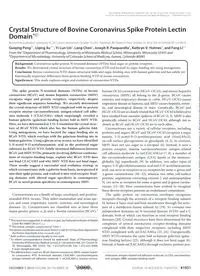
2012 Crystal Structure of Bovine Coronavirus Spike Protein Lectin Domain PDF
Preview 2012 Crystal Structure of Bovine Coronavirus Spike Protein Lectin Domain
Crystal Structure of Bovine Coronavirus Spike Protein Lectin Domain*□ S Received for publication,September 10, 2012, and in revised form, October 19, 2012 Published, JBC Papers in Press,October 22, 2012, DOI 10.1074/jbc.M112.418210 Guiqing Peng‡1, Liqing Xu ‡1, Yi-Lun Lin‡, Lang Chen‡, Joseph R. Pasquarella‡, Kathryn V. Holmes§, and Fang Li‡2 From the ‡Department of Pharmacology, University of Minnesota Medical School, Minneapolis, Minnesota 55455 and §Department of Microbiology, University of Colorado School of Medicine, Aurora, Colorado 80045 Background: Coronavirus spike protein N-terminal domains (NTDs) bind sugar or protein receptors. Results: We determined crystal structure of bovine coronavirus NTD and located its sugar-binding site using mutagenesis. Conclusion: Bovine coronavirus NTD shares structural folds and sugar-binding sites with human galectins and has subtle yet functionally important differences from protein-binding NTD of mouse coronavirus. Significance: This study explores origin and evolution of coronavirus NTDs. The spike protein N-terminal domains (NTDs) of bovine coronavirus (BCoV) and mouse hepatitis coronavirus (MHV) recognize sugar and protein receptors, respectively, despite their significant sequence homology. We recently determined the crystal structure of MHV NTD complexed with its protein receptor murine carcinoembryonic antigen-related cell adhe- sion molecule 1 (CEACAM1), which surprisingly revealed a human galectin (galactose-binding lectin) fold in MHV NTD. Here, we have determined at 1.55 Å resolution the crystal struc- ture of BCoV NTD, which also has the human galectin fold. Using mutagenesis, we have located the sugar-binding site in BCoV NTD, which overlaps with the galactose-binding site in human galectins. Using a glycan array screen, we have identified 5-N-acetyl-9-O-acetylneuraminic acid as the preferred sugar substrate for BCoV NTD. Subtle structural differences between BCoV and MHV NTDs, primarily involving different conforma- tions of receptor-binding loops, explain why BCoV NTD does not bind CEACAM1 and why MHV NTD does not bind sugar. These results suggest a successful viral evolution strategy in which coronaviruses stole a galectin from hosts, incorporated it into their spike protein, and evolved it into viral receptor-bind- ing domains with altered sugar specificity in contemporary BCoV or novel protein specificity in contemporary MHV. Coronaviruses are a family of large, enveloped, and positive- stranded RNA viruses. They infect mammalian and avian spe- cies and cause respiratory, enteric, systemic, and neurological diseases (1). Coronaviruses are classified into at least three major genetic genera: �, �, and �. Bovine coronavirus (BCoV),3 human OC43 coronavirus (HCoV-OC43), and mouse hepatitis coronavirus (MHV) all belong to the �-genus. BCoV causes enteritis and respiratory disease in cattle, HCoV-OC43 causes respiratory disease in humans, and MHV causes hepatitis, enteri- tis, and neurological disease in mice. Genetically, BCoV and HCoV-OC43aresocloselyrelatedthatHCoV-OC43isbelievedto have resulted from zoonotic spillover of BCoV (2, 3). MHV is also genetically related to BCoV and HCoV-OC43, although not as closely as BCoV and HCoV-OC43 are to each other. Coronaviruses use a variety of cellular receptors, including proteins and sugars. BCoV and HCoV-OC43 recognize a sugar moiety, 5-N-acetyl-9-O-acetylneuraminic acid (Neu5,9Ac2), on cell-surface glycoproteins or glycolipids (4, 5). In contrast, MHV does not use sugar as a receptor (6). Instead, it uses a protein receptor, murine carcinoembryonic antigen-related cell adhesion molecule 1a (mCEACAM1a) (7, 8), a member of the carcinoembryonic antigen (CEA) family in the immuno- globulin (Ig) superfamily (9). In addition, two other types of sugars, 5-N-glycolylneuraminic acid and 5-N-acetylneuraminic acid, can serve as receptors or co-receptors for some �-genus and �-genus coronaviruses (10–12), whereas two other cell-surface proteins, angiotensin-converting enzyme 2 and aminopeptidase N, can serve as receptors for some �-genus and �-genus corona- viruses (13–18). How coronaviruses have evolved to recognize these diverse receptors presents an evolutionary conundrum. The spike protein on coronavirus envelopes recognizes receptors through the activities of a receptor-binding subunit S1 before it fuses viral and host membranes through the activ- ities of a membrane-fusion subunit S2 (19). S1 contains two independent domains, an N-terminal domain (NTD) and a C domain, both of which can function as viral receptor-binding domains (20). Crystal structures have been determined for the complexes of several coronavirus receptor-binding domains complexed with their respective receptors, including MHV NTD complexed with mCEACAM1a (21–24). Unexpectedly, MHV NTD contains the same fold as human galectins (galac- tose-binding lectins) (22), although it does not bind sugar (6). Instead, it binds mCEACAM1a through exclusive protein-pro- * Thisworkwassupported,inwholeorinpart,byNationalInstitutesofHealth Grant R01AI089728 (to F. L.). □ S This article contains supplemental Table 1. Theatomiccoordinatesandstructurefactors(code4H14)havebeendepositedin the Protein Data Bank (http://wwpdb.org/). 1 Both authors contributed equally to this work. 2 To whom correspondence should be addressed: Dept. of Pharmacology, University of Minnesota Medical School, 6-120 Jackson Hall, 321 Church St. SE, Minneapolis, MN 55455. Tel.: 1-612-625-6149; Fax: 1-612-625-8408; E-mail:
